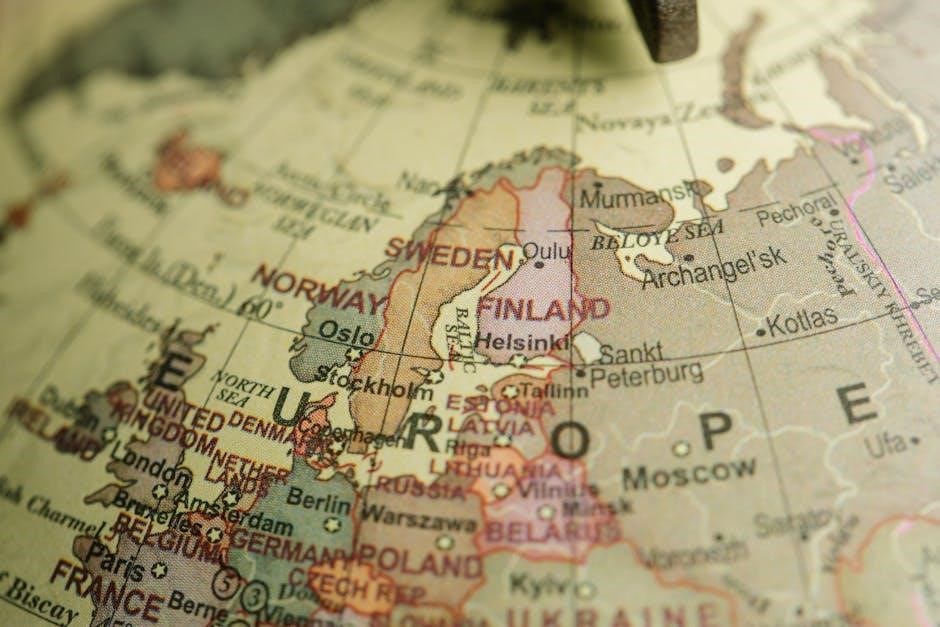Causes of World War I
The primary causes of World War I included nationalism, imperialism, militarism, and alliances. Nationalism fueled pride and rivalry among nations, while imperialism drove competition for colonies. Militarism increased tensions as nations expanded their armies, and complex alliances created a volatile system where a small conflict could escalate into a global war.
1.1 Nationalism
Nationalism played a pivotal role in the outbreak of World War I. It fostered intense pride and loyalty among nations, often leading to a desire for independence and self-determination. This sentiment was particularly strong in the Balkans, where ethnic groups sought to break free from foreign rule. Nationalist ideologies fueled competition among European powers, as countries prioritized their own interests over collective stability. The belief in the superiority of one’s nation created an environment of tension and rivalry, making it easier for smaller conflicts to escalate into a broader war. Nationalism also influenced political decisions, as leaders often acted to protect or expand their nation’s influence. This heightened sense of national identity contributed significantly to the volatile pre-war atmosphere.
1;2 Imperialism
Imperialism was a major cause of World War I, as European nations competed for colonies and resources. This competition led to increased tensions and rivalries. Countries sought to expand their empires to gain economic advantages, such as raw materials and markets, which often led to conflicts over territories. Imperialist policies also contributed to the formation of alliances, as nations sought to protect their interests abroad. The scramble for Africa and Asia intensified rivalries, particularly between Britain, France, Germany, and Belgium. This competition for global dominance created an unstable international environment, making war more likely. Imperialism thus played a significant role in the complex system of alliances and rivalries that led to the outbreak of World War I.
1.3 Militarism
Militarism played a significant role in the outbreak of World War I. European nations engaged in an arms race, expanding their military forces and glorifying war. Germany, under Kaiser Wilhelm II, sought to challenge Britain’s naval dominance by building a powerful navy. France and Russia also increased their military capabilities. This buildup created an atmosphere of tension and competition. Militarism influenced political decisions, as leaders often prioritized military strength over diplomacy. The complex system of alliances further amplified tensions, as nations felt pressured to defend their allies. Additionally, the glorification of military power in propaganda and nationalistic rhetoric made war seem inevitable. Militarism thus heightened the likelihood of conflict, contributing to the eruption of World War I.
1;4 Alliances
The complex system of alliances before World War I created a volatile diplomatic landscape. The Triple Entente, consisting of France, Russia, and Britain, sought to balance the power of the Triple Alliance, which included Germany, Austria-Hungary, and Italy. These alliances were intended to maintain stability, but they ultimately escalated tensions. When Austria-Hungary declared war on Serbia, Russia mobilized to support Serbia, leading Germany to declare war on Russia and France. Britain then entered the conflict to defend Belgium, drawing more nations into the war. This chain reaction highlighted how alliances transformed a regional dispute into a global conflict, making it difficult to contain the spread of hostilities.

Key Events of World War I
The assassination of Archduke Franz Ferdinand sparked the war, while Germany’s invasion of Belgium drew Britain into the conflict. The U.S. entered in 1917.
2.1 Assassination of Archduke Franz Ferdinand

The assassination of Archduke Franz Ferdinand, heir to the Austro-Hungarian throne, by Gavrilo Princip in Sarajevo on June 28, 1914, was the immediate trigger of World War I. This act of violence, carried out by a Serbian nationalist, escalated tensions between Austria-Hungary and Serbia. Austria-Hungary issued an ultimatum to Serbia, which led to the involvement of other European powers through their complex system of alliances. The event marked the beginning of a chain reaction that eventually plunged Europe into war, highlighting how a single incident could spark a global conflict due to existing political and military alliances.
2.2 Invasion of Belgium and Germany’s War Plan
Germany’s invasion of Belgium in August 1914 was a key event in the early stages of World War I. The invasion was part of Germany’s Schlieffen Plan, which aimed to quickly defeat France by bypassing its defenses through neutral Belgium. This act violated Belgium’s neutrality, guaranteed by European powers, including Britain, which then declared war on Germany. The invasion led to widespread destruction and resistance, forcing Britain to enter the war. The plan’s failure to achieve a swift victory contributed to the prolonged conflict and the eventual stalemate on the Western Front, marking the beginning of a brutal and lengthy war.

Major Battles of World War I
The Battle of the Somme and Verdun were pivotal, showcasing brutal trench warfare and massive casualties. These battles highlighted the devastating impact of modern weaponry and stalemate tactics.
3.1 Battle of the Somme
The Battle of the Somme, fought from July to November 1916, was a devastating conflict during World War I. It was characterized by massive casualties on both sides, with over one million soldiers killed or wounded. The battle began with a seven-day British artillery bombardment, which failed to break through German defenses. On the first day alone, the British suffered nearly 60,000 casualties. The introduction of tanks in September 1916 marked a turning point but did not lead to a decisive victory. The battle ended in stalemate, highlighting the horrors of trench warfare and the futility of frontal assaults.
3.2 Battle of Verdun
The Battle of Verdun, fought from February to December 1916, was one of the longest and bloodiest battles of World War I. Initiated by Germany to weaken France, it centered on the strategic fortress city of Verdun-sur-Meuse. The German army launched massive artillery attacks, but French forces, under General Philippe Pétain, held their ground despite heavy losses. The battle became a symbol of French resilience, with the famous phrase “Ils ne passeront pas” embodying their determination. Both sides suffered over 700,000 casualties, making it a stark example of the war’s futility and human cost. The battle ended with minimal territorial changes but profound psychological impact.
Technological Advancements and Warfare
World War I saw significant technological advancements that transformed warfare, including trench warfare, tanks, and aerial combat. These innovations increased warfare’s scale and destructiveness, shaping modern conflict strategies.
4.1 Trench Warfare
Trench warfare became a defining feature of World War I, particularly on the Western Front. Both Allied and Central Powers dug extensive networks of trenches, creating stalemates and prolonged battles. Soldiers endured horrific conditions, including mud, disease, and constant artillery fire. Trenches provided limited protection but made mobility nearly impossible, leading to massive casualties. The psychological toll was immense, as soldiers faced relentless bombardment and the ever-present threat of death. Trench warfare exemplified the brutal and static nature of modern combat, forcing military leaders to adapt strategies and leading to the development of new technologies, such as tanks, to break the deadlock.
4.2 Development of Tanks
The development of tanks during World War I revolutionized land warfare. Initially introduced by the British in 1916, tanks were designed to overcome the stalemate of trench warfare by breaking through enemy lines and protecting infantry. These early armored vehicles were slow, cumbersome, and prone to mechanical failures, but they marked a significant technological advancement. Tanks provided cover from machine-gun fire and could cross trenches, allowing for new offensive strategies. Despite their limitations, tanks symbolized the shift toward mechanized warfare and laid the groundwork for their widespread use in future conflicts, making them a crucial innovation of the Great War.
4.3 Aerial Warfare
Aerial warfare emerged during World War I, initially used for reconnaissance and scouting missions. As the war progressed, planes were adapted for combat, leading to the development of fighter aircraft and bombers. The introduction of synchronized machine guns allowed planes to fire through propellers, enhancing their offensive capabilities. Airships, like zeppelins, were also used for bombing and reconnaissance. Aerial warfare significantly impacted military tactics, providing new ways to gather intelligence and attack enemy positions. By the end of the war, airpower had become a crucial component of modern warfare, setting the stage for its expanded role in future conflicts.

Consequences of World War I
The war led to the Treaty of Versailles, territorial redrawing, economic turmoil, and widespread political instability. It also fueled the rise of fascism and communism globally.
5.1 Treaty of Versailles
The Treaty of Versailles, signed in 1919, officially ended World War I. It imposed harsh penalties on Germany, including heavy reparations and territorial losses. The treaty’s “war guilt” clause blamed Germany for the conflict, leading to widespread resentment. It also established the League of Nations to promote peace, though its effectiveness was limited. The treaty’s terms are often seen as contributing to economic and political instability in Germany, which later enabled the rise of Adolf Hitler and the Nazi Party. These consequences played a significant role in the lead-up to World War II.
5.2 Economic and Political Impact
World War I caused significant economic and political upheaval globally. Many nations faced severe debt due to wartime spending, leading to inflation and economic instability. Industries shifted focus to war production, disrupting traditional economies. Unemployment rose, and post-war recessions affected recovery. Politically, the war destabilized governments, contributing to revolutions, such as Russia’s February and October Revolutions. The collapse of empires like Austria-Hungary and the Ottoman Empire reshaped global power structures. The rise of the United States as a dominant world power and the spread of democratic ideals were notable outcomes. However, the war also sowed seeds of political extremism, setting the stage for future conflicts.